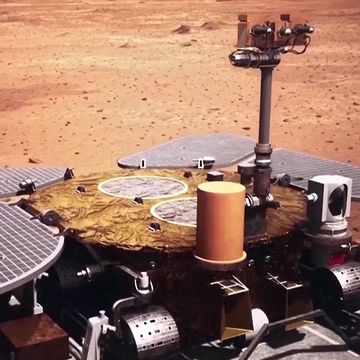- NASA is readying its 2020 rover for its trip to Mars. The rover has been able to stand on its six wheels for the first time.
- Approximately the size of an SUV, the rover will be able to make 360-degree turns in place
- When the rover gets to the untamed terrain of Mars, it will be able to climb terrain on as much as a 45-degree angle.
NASA's 2020 Mars rover continues to make progress with one small stand. On October 8, NASA captured the rover standing independently with its full weight on its own six wheels. These baby steps come after weeks of simulating the near-vacuum the rover will operate with on Mars.
"After years of design, analysis and testing, it is fantastic to see the rover on her wheels for the first time," said Ben Riggs, a mechanical systems engineer working on Mars 2020 at the Jet Propulsion Lab (JPL), in a press statement. "The whole team looks forward to seeing her in the same configuration on Mars in the not too distant future."
Baby steps for a rover are slightly different with one reason being that its legs are made out of titanium. Another is that its wheels are made of aerospace-grade aluminum. The wheels are 20.7 inches (52.5 centimeters) in diameter and machined with traction-providing cleats, or grousers, although the ones the rover is wearing in this particular iteration will be replaced before the actual launch.
Each of the rover's six wheels has its own motor, and the rover's two front and two back wheels have individual steering motors which will allow the vehicle, approximately the size of an SUV, to make a full 360 turn in place.
Mars is as unpaved as terrain gets, and the rover's counter is a "rocker-bogie" suspension system which is able keep constant weight on each wheel to maintain the rover's stability. The rover's remote drivers will work to avoid any Martian terrain that could cause the vehicle to tilt over 30 degrees, but if push comes to shove it could handle a 45-degree tilt without turning over.
The Mars 2020 rover will launch in 2020 and land on the Red Planet in 2021, specifically in the Jezero Crater. NASA chose the site specifically to learn more about the possibility of historic Martian life. There has never been any sign of life—historic or otherwise—on Mars, though conditions suggestive of the possibility of life have been discovered.
If the 2020 rover discovers anything, scientists will know its rover can turn on a dime to get a closer look.
David Grossman is a staff writer for PopularMechanics.com. He's previously written for The Verge, Rolling Stone, The New Republic and several other publications. He's based out of Brooklyn.












